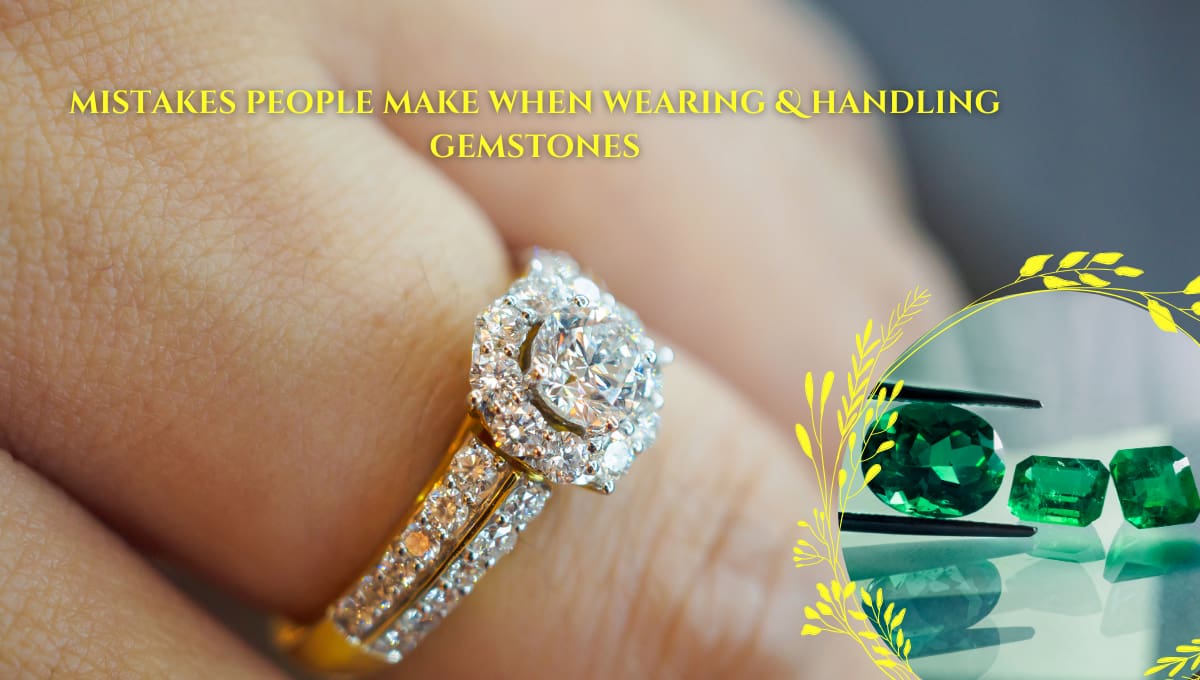Gemstones are some of the most valuable entities revered and embraced by humans since time immemorial. Gemstones encapsulate life-transforming and sacred vibes that humans wish to harness to influence different aspects of life like financial, personal, professional, and marital. To elongate the longevity and effectiveness of a gemstone, it should be handled and worn with utmost care.
Most people often ignore wearing & handling instructions provided by gemstone dealers when it comes to taking subtle care of gemstones. As a result, either gemstones break or lose their effectiveness which results into complaints from customers. Despite reading the dos and don’ts manual, people often commit mistakes unintentionally and dwindle the potential of gemstones. In this blog post, we will dive deep into the most common mistakes made by gemstone wearers and how to avoid them by sticking to certain time-tested tips. Let’s get started!
Table of Contents
Mistakes to Avoid When Wearing Gemstones
Exposing Gemstones to Chemicals
Exposing gemstones to chemicals can have various effects depending on the type of gemstone and the specific chemical involved. Here are some general outcomes:
Surface Damage: Many gemstones can suffer surface damage when exposed to harsh chemicals. For example, acids and alkalis can etch or dull the surface of softer stones like opals, pearls, and turquoise.
Color Changes: Certain chemicals can alter the color of gemstones. Bleach and ammonia can cause discoloration in organic gems like pearls and amber. Heat and certain cleaning solutions can also fade the color of dyed or treated stones.
Structural Integrity: Some chemicals can weaken the structural integrity of gemstones. For instance, opals contain water and can crack or craze when exposed to chemicals that dry them out. Acids can corrode stones like calcite and marble.
Loss of Polish: Chemicals can remove the polish from gemstones, making them appear dull. This is particularly true for softer stones and those with treated surfaces.
Metal Settings Damage: While not affecting the gemstone directly, chemicals can corrode the metal settings of jewelry, potentially causing damage to the mounted gemstones.
Frequent Removal of Gemstones
Frequent removal and replacement of gemstones can cause physical damage, such as scratches, chips, or cracks, especially if the process is not done carefully by a professional.Repeated removal and replacement of gemstones can affect their value, particularly for precious or rare stones. The value of a gemstone is often tied to its natural integrity and provenance, which can be compromised by frequent handling and removal.
If gemstones are set in jewelry, frequent removal and replacement can weaken the metal settings or the overall structural integrity of the piece, potentially causing it to break or the gemstones to fall out.
Incorrect Metal Settings
Durability and Protection: Certain metals are better suited to protect specific gemstones. For example, softer metals might not provide adequate protection for harder gemstones, leading to potential damage.
Compatibility and Wear: The chemical interaction between the gemstone and the metal can cause discoloration or deterioration. For example, some gemstones may react poorly with metals that tarnish easily, leading to unsightly appearances.
Setting Stability: Some metals provide better settings for securing the gemstone in place. An incorrect metal setting might be too soft or too hard, risking the gemstone becoming loose or damaged.
Sharing Gemstones with Others
Gemstones have monetary value, so giving one away represents a financial loss for the giver but a gain for the recipient. The more valuable the gemstone, the greater the financial impact. Many gemstones are rare, meaning their value is tied to their limited supply. If a gemstone owner shares too many stones, it can decrease their perceived rarity and value over time through increased supply.
Ignoring Regular Maintenance
Just like any cherished possession, gemstones need regular care and maintenance. Failing to clean and recharge them can diminish their effectiveness. To ensure your gemstones continue to exert their beneficial influence, make it a routine to periodically cleanse, recharge, and reprogram them. This practice will help maintain their potency and magic in your life.
Failing to Align Intentions with Gemstones
Gemstones possess an innate power and vibrational energy that can be harnessed and directed through conscious intention and programming. Much like a blank canvas awaits the strokes of a painter’s brush, gemstones are vessels ready to be imbued with the focused intentions of their wearer or user. However, failing to actively program these gemstones with specific goals or desired outcomes can significantly limit their potential effectiveness.
Before adorning yourself with a gemstone or utilizing it in any practice, it is essential to take a moment of mindful presence and clearly define your intentions. This act of conscious programming allows you to infuse the gemstone with the vibrational frequencies that align with your goals, desires, or the specific energies you wish to attract or cultivate within your life.
By focusing your mental, emotional, and spiritual intentions upon the gemstone, you essentially encode it with a customized energetic blueprint, amplifying its capacity to act as a powerful catalyst for manifestation. This intentional programming not only enhances the gemstone’s ability to resonate with your specific objectives but also strengthens its connection to your personal energy field, creating a harmonious synergy that can facilitate profound transformation.
